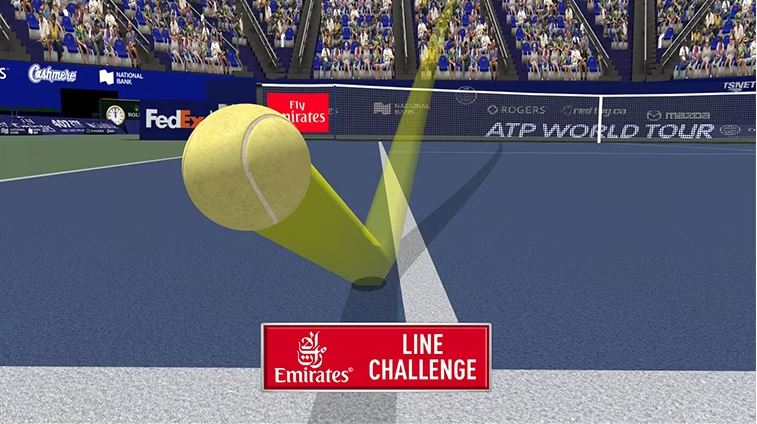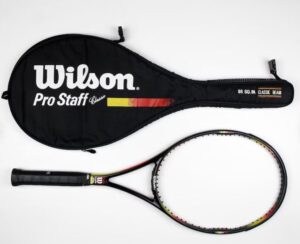Unveiling the Precision: Line Calling Systems in Tennis Tournaments

Tennis is a sport where accuracy and fairness play a crucial role. For decades, line calls have been a source of contention, with players, spectators, and officials sometimes disagreeing on crucial points. However, recent technological advancements like Hawk-Eye have revolutionized the way line calls are made in tennis tournaments.
In this article, we will explore Hawk-Eye and other line calling systems used in modern tennis and delve into how they work to ensure precise and fair judgments.
Traditional Line Calling Challenges

Before the advent of line calling technology, tennis matches relied on human line judges to determine whether a ball landed within the boundaries of the court. While line judges were generally accurate, they were susceptible to human error, and occasional mistakes could lead to controversies and heated debates between players. Additionally, line judges had to endure long matches, potentially affecting their concentration and judgment.
Hawk-Eye Tennis Line Calling System
The Hawk-Eye system, developed by Dr. Paul Hawkins, emerged as a game-changer in the world of tennis officiating. Hawk-Eye technology was introduced in ATP (Association of Tennis Professionals) tournaments in 2006.
It made its debut at the Miami Open in March 2006, becoming the first ATP tournament to utilize the system for line calling. Since then, Hawk-Eye has become a staple technology in the world of professional tennis, being widely employed in numerous ATP tournaments, including the prestigious Grand Slam events and ATP Tour Masters 1000 series.
The introduction of Hawk-Eye has significantly influenced the accuracy and fairness of line calls in ATP tournaments, reducing controversies and enhancing the overall experience for players and fans.
How does Hawk-Eye Technology Work
Hawk-Eye technology is a complex system that utilizes a combination of cameras, computer algorithms, and mathematical models to provide accurate line calls in tennis. Here’s a step-by-step breakdown of how Hawk-Eye works:
- Multiple Camera Setup: Hawk-Eye employs a network of high-speed cameras placed strategically around the tennis court. The number of cameras can vary but is typically around six to ten. These cameras are positioned to cover different angles and perspectives of the court.
- Ball Tracking: As the tennis ball is in play, the cameras capture its movement from various angles. The system analyzes the footage captured by these cameras to track the ball’s trajectory in three-dimensional space.
- Image Processing: Hawk-Eye’s computer algorithms process the video frames captured by the cameras. The algorithms detect the ball’s position in each frame and create a digital representation of its flight path.
- Calibration and Alignment: Before a match, the Hawk-Eye system undergoes a calibration process. This involves mapping the positions of the cameras and aligning them accurately to create a unified coordinate system. This calibration is crucial for accurate tracking and measurement.
- Triangulation: Hawk-Eye utilizes a process called triangulation to determine the ball’s precise position in 3D space. By comparing the ball’s position from multiple camera angles, the system calculates the exact coordinates of the ball at any given moment.
- Ball Bounce Prediction: Based on the ball’s trajectory and speed, Hawk-Eye’s algorithms predict the future path of the ball and its likely landing point. This prediction takes into account factors such as ball spin, speed, and initial trajectory.
- Replay and Visualization: Hawk-Eye generates a visual representation of the ball’s flight path, including its predicted bounce location. This data is superimposed onto a digital representation of the tennis court, allowing officials, players, and spectators to see precisely where the ball landed.
- Instant Decision-Making: The information provided by Hawk-Eye is relayed to the umpire or an automated system that makes the final line call decision. If a challenge system is in place, players can request reviews of specific line calls.
- Challenges and Review Process: In tournaments with challenge systems, players have a limited number of challenges they can use to contest line calls. The Hawk-Eye data is reviewed during the challenge process, and the final decision is made based on the information provided by the system.
Hawk-Eye technology has significantly enhanced the accuracy and efficiency of line calls in tennis, reducing human error and increasing fairness in the game. Its implementation has become a standard feature in major tennis tournaments worldwide.
Challenges and Limitations of Hawk-Eye Technology
While the Hawk-Eye system has significantly improved line calling accuracy, it is not without its limitations:
- Margin of Error: Hawk-Eye claims an average margin of error of around 3.6 millimeters, which is incredibly precise. However, disputes can still arise when a call is close to the edge of the boundary, leading to subjective interpretations.
- Court Surface Influence: Different court surfaces, such as grass, clay, and hard court, can impact ball bounces. Hawk-Eye accounts for these variations but may encounter challenges in accurately predicting bounces on some surfaces.
- Cost and Accessibility: Implementing the Hawk-Eye system requires significant financial resources, making it primarily available in major tournaments. Smaller tournaments often rely on traditional line judges due to budget constraints.
- Limited Challenges: In most professional tennis tournaments, players are allowed to challenge a limited number of line calls per set. This constraint prevents unlimited use of the Hawk-Eye system and means that human error can still impact the outcome of matches.
Other Tennis Line Calling Systems
In addition to Hawk-Eye, other line calling systems have emerged in recent years, providing alternative options for tournament organizers and players. These systems include:
- FoxTenn: Utilizing artificial intelligence and machine learning algorithms, FoxTenn provides real-time line calls and instant replays with remarkable accuracy.
- PlaySight: This system combines high-resolution cameras with cloud-based video analysis to offer real-time line calls, ball tracking, and player performance statistics.
- Cyclops: Cyclops uses infrared technology to detect service line faults, alerting the umpire if a serve exceeds the allowed margin for error.
The advent of line calling systems has transformed the world of tennis officiating. Hawk-Eye and other cutting-edge technologies have brought unprecedented accuracy to line calls, reducing human error and enhancing the fairness of the game.
While these systems have their limitations, they continue to evolve, setting the stage for a future where line disputes will become increasingly rare. The fusion of technology and tennis ensures a more precise and engaging experience for players and fans alike.
FAQ
Most Frequently Asked Questions and Answers
Hawk-Eye is a line calling system that uses a combination of high-speed cameras, computer algorithms, and mathematical models to make accurate line calls in tennis. It was introduced in ATP tournaments in 2006, making its debut at the Miami Open in March of that year.
Hawk-Eye uses a network of high-speed cameras placed around the tennis court to capture the ball’s movement. It employs computer algorithms to process this footage and uses mathematical models like triangulation to determine the ball’s precise position in 3D space. Based on this, it predicts the ball’s future path and likely landing point.
Hawk-Eye claims an average margin of error of around 3.6 millimeters, making it incredibly precise for line calling in tennis.
While Hawk-Eye is highly accurate, it is not infallible. There have been instances where its decisions were disputed or questioned, although the chair umpire did not overturn these calls. For example:
-
2013 Wimbledon Semi-final: During the match between Novak Djokovic and Juan Martín del Potro, Hawk-Eye showed a ball as out. TV replays suggested otherwise, sparking debates about the system’s reliability, even though the chair umpire did not overturn the decision.
-
2020 ATP Cup: In a match involving Denis Shapovalov, Hawk-Eye made a call that was challenged by Shapovalov. The Hawk-Eye review showed the ball as actually in, contrary to the original call. While the chair umpire did not overturn this decision, it led to discussions about the technology’s margin of error.
Generally, Hawk-Eye’s calls are considered final, especially in tournaments where it is the primary line-calling system. However, these examples show that it’s not 100% foolproof and can still be a subject of debate.
As of 2025, the ATP men’s tour will no longer use line judges, relying instead on Electronic Line Calling Live (ELC Live) for “out” calls in all matches. While each match will still be overseen by a chair umpire, line judges will no longer be present on court.
This change began to gain momentum at the 2017 Next Gen ATP Finals when ELC Live was first tried on the men’s tour. It should be noted that this policy will apply to every surface, including clay courts, despite some resistance from tournaments like the French Open.
The shift toward electronic line-calling in tennis gained significant traction during the Covid-19 era.
Initially, the 2020 U.S. Open eliminated the need for human line judges on most of its main courts, retaining them only on a couple. The Australian Open took it a step further in 2021 by becoming the first of the Grand Slam events to fully integrate electronic line-calling across all of its courts. The U.S. Open followed suit in 2022, removing line judges from all competition courts.
Currently, among the Grand Slams, only the French Open, held on clay courts, continues to use human line judges.
In tournaments with challenge systems, players can use a limited number of challenges to contest line calls. The Hawk-Eye data is reviewed during this process, and the final decision is made based on the information provided by the system.
Yes, as technologies like artificial intelligence and machine learning become more advanced, line calling systems are expected to continue evolving. This will further reduce human error and make the sport even more fair and engaging for all involved.


